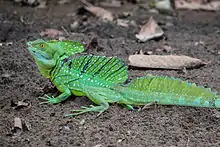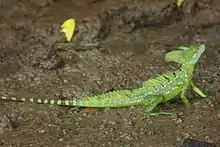Plumed basilisk
The plumed basilisk (Basiliscus plumifrons), also called commonly the green basilisk, the double crested basilisk, or the Jesus Christ lizard, is a species of lizard in the family Corytophanidae. The species is native to Central America.
| basilisk[1] | |
|---|---|
 | |
| Male, Alajuela Province, Costa Rica | |
 | |
| Female plumed basilisk | |
| Scientific classification | |
| Kingdom: | Animalia |
| Phylum: | Chordata |
| Class: | Reptilia |
| Order: | Squamata |
| Suborder: | Iguania |
| Family: | Corytophanidae |
| Genus: | Basiliscus |
| Species: | B. plumifrons |
| Binomial name | |
| Basiliscus plumifrons | |
Geographic range
The natural distribution of B. plumifrons ranges from eastern Honduras, through Nicaragua and Costa Rica, to western Panama.[3][4]
Taxonomy and etymology
The Green basilisk's generic name Basiliscus is taken from the legendary reptilian creature of European mythology which could turn a man to stone by its gaze: the Basilisk.[5] This name derives from the Greek basilískos (βασιλίσκος) meaning "little king".[5] This generic name was given in Carl Linnaeus' 10th edition of Systema Naturae.[5]
For the origin of the nickname "Jesus Christ lizard", see § Behaviour.
Description

The plumed basilisk is the largest basilisk species, with an average snout-to-vent length (SVL) of approximately 10 inches (25 cm). Including the tail, it can reach 3 feet (91 cm) in total length. Adults are brilliant green, with bright yellow eyes, and small bluish spots along the dorsal ridge. Males have three crests: one on the head, one on the back, and one on the tail, while females only have the head crest.[6] Juveniles are less conspicuously colored, and lack the characteristic crests.[7]
Diet
The plumed basilisk is omnivorous and eats insects, spiders, small mammals (such as rodents), small birds, small nonvenomous snakes, smaller species of lizards, amphibians, small fish, crustaceans (such as freshwater shrimp and crayfish), fruits, seeds, flowers and leaves.[8]
Predators
The predators of B. plumifrons include birds of prey, opossums, coati, and snakes.
Reproduction
Sexually mature females of B. plumifrons lay five to fifteen eggs at a time in warm, damp sand or soil. The eggs hatch after eight to ten weeks, at which point the young emerge as fully independent lizards.
Behaviour
Male plumed basilisks are very territorial; a single male may keep land containing a large group of females with whom he mates. Most plumed basilisks are skittish, and do not tolerate much handling when kept in captivity.
B. plumifrons is able to run short distances across water using both its feet and tail for support, an ability shared with other basilisks and the Malaysian sail-finned lizard, Hydrosaurus amboinensis. In Costa Rica, this has earned the plumed basilisk the nickname "Jesus Christ lizard." It is also an excellent swimmer and can stay under water for up to an hour.
References
- "Basiliscus plumifrons ". Integrated Taxonomic Information System. Retrieved July 14, 2018.
- "Basiliscus plumifrons ". The Reptile Database. www.reptile-database.org.
- Köhler G (2008). Reptiles of Central America, 2nd Edition. Offenbach, Germany: Herpeton Verlag. 400 pp. ISBN 978-3936180282
- Savage JM (2005). The Amphibians and Reptiles of Costa Rica: A Herpetofauna between Two Continents, between Two Seas. Chicago and London: University of Chicago Press. xx + 945 pp. ISBN 978-0226735382
- Sprackland, Robert George (1992). Giant lizards. Neptune, New Jersey: TFH Publications. ISBN 0-86622-634-6.
- Lanferwerf, Bert (2018). "Basilisk Lizard Care And Information". www.reptilesmagazine.com. Retrieved 2015-09-01.
- Reid, Fiona A.; et al. (2010). The Wildlife of Costa Rica: A Field Guide. Cornell University Press. p. 169. ISBN 978-0801476105.
- Spinner, Leo (2018). "Plumed Basilisk Lizard Care Tips". www.reptilesmagazine.com. Retrieved 2015-09-01.
External links
| Wikimedia Commons has media related to Basiliscus plumifrons. |
| Wikispecies has information related to Basiliscus plumifrons. |
- Green Basilisk. Honolulu Zoo web site.
- Image of Plumed Basilisk.
- https://animals.mom.me/types-animals-jesus-lizards-predator-6521.html.
Further reading
- Cope ED (1865). "On the Batrachia and Reptilia of Costa Rica. With notes on the Herpetology and Ichthyology of Nicaragua and Peru". J. Acad. Nat. Sci. Philadelphia, Second Series 8: 93-188. (Basiliscus plumifrons, new species, pp. 125–127).